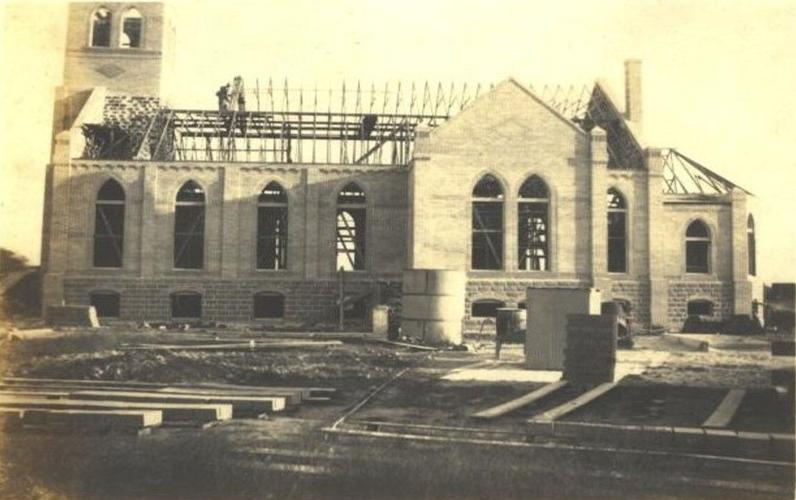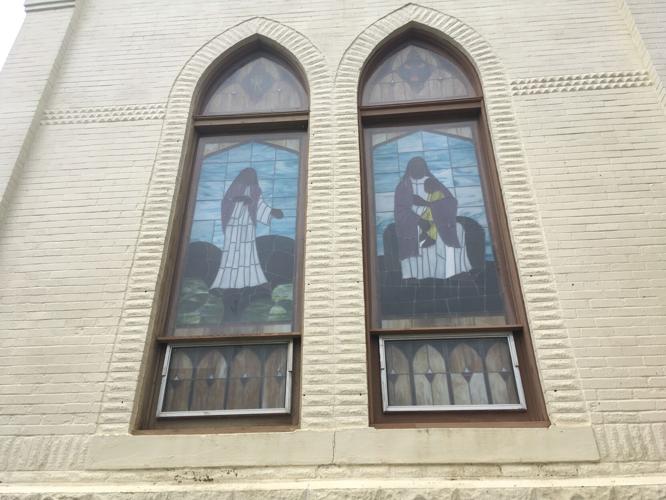MEYERSVILLE – The walls of the Gothic-style, cross-shaped St. John Evangelical Lutheran Church have enveloped worshippers in Meyersville for 100 years. And the largely German congregation is even older.
The congregation started in a log cabin in 1851 before moving to a stone church in 1866. St. John’s congregation is one of the three oldest Lutheran congregations in Texas. No one is exactly sure which one started first, said the Rev. John Boor, the 21st pastor of St. John Evangelical Lutheran Church.
Ranchers from the community decided to build the church in 1919, and they started construction in 1920 with help from a contractor who provided technical guidance. They didn’t have a store from which to purchase the bricks, so they had to make their own bricks from scratch on-site. For the foundation of the church, they hauled large concrete blocks from Yorktown, which required a full day’s travel, Boor said.
The church was built with a slight incline heading toward the altar so everyone in the church could see the pastor. While the building practice is nothing new today, at that time, building the incline was advanced, Boor said.
The church was completed in 17 months and dedicated in July 1921. The Rev. Christoph Adam Sager was the first pastor of the church. The sanctuary seats 250 people comfortably and cost $20,000 to build.
“That was big money back then,” Boor said.
On the backs of the pews on the left side of the church are metal clips that were used by the men to hold their Stetson hats. In the old days, all the men sat on the left side of the church while all the women sat on the right side. Metal fans remain attached to the walls and point downward toward the pews even though air conditioning was installed in the church around 2004. In 2019, a new elevator, staircase and covered drop-off area were built on the side of the church.
The congregation possesses notes from the church council that date back to the 1800s, which are written in German. One of the big debates in the church was about ending services in German. In 1951, members of the congregation voted to have German services once a month, and in 1964, the German services were discontinued altogether. The German services lasted for such a long period of time because the older generations studied the Bible in German and were confirmed in German.
“They had a relationship with God in German, so the English didn’t mean as much to them as the German,” said Carol Ann Nagel Sagebiel, a church member who was baptized, confirmed and married in the church. “It’s not just that they didn’t want to stop German services — that was how their relationship with God was formed, how it worked.”
Boor arrived at the church 10 years ago and said he was blessed to arrive in time to know the older generation.
“The church played a very, very important role in their lives,” Boor said. “There were no excuses for not coming to church on Sundays.”
Kathy Egg Dunn, who was baptized, confirmed and married in the church as well, said that high water was one of the only legitimate excuses for not attending church. She lived practically next door to the church growing up so she and her parents attended services every Sunday along with both sets of her grandparents. They also attended church social events.
“It was one of the most important things in my life,” Dunn said.
Of about 300 members, 100 were active before the pandemic. Now that the pandemic has started to recede, the number of active members hovers in the high 80s.
Sagebiel said that her church is a family.
“We all care about each other and praise God together,” she said.
Obert Sagebiel, Carol Ann Sagebiel’s husband, said he felt welcomed by the church as an outsider from Fredericksburg, and visitors cannot help but love the church’s unique and beautiful structure.
“I was always accepted, and it continues to be a friendly, welcoming and open congregation,” he said.
A large percentage of the church members are related. Many were born and reared in Meyersville.
“Some go off to work and have their careers, and they come back to Meyersville when they retire,” Boor said. “I’m sure this generation leaving now will come back because it is such a close, tight-knit community.”













